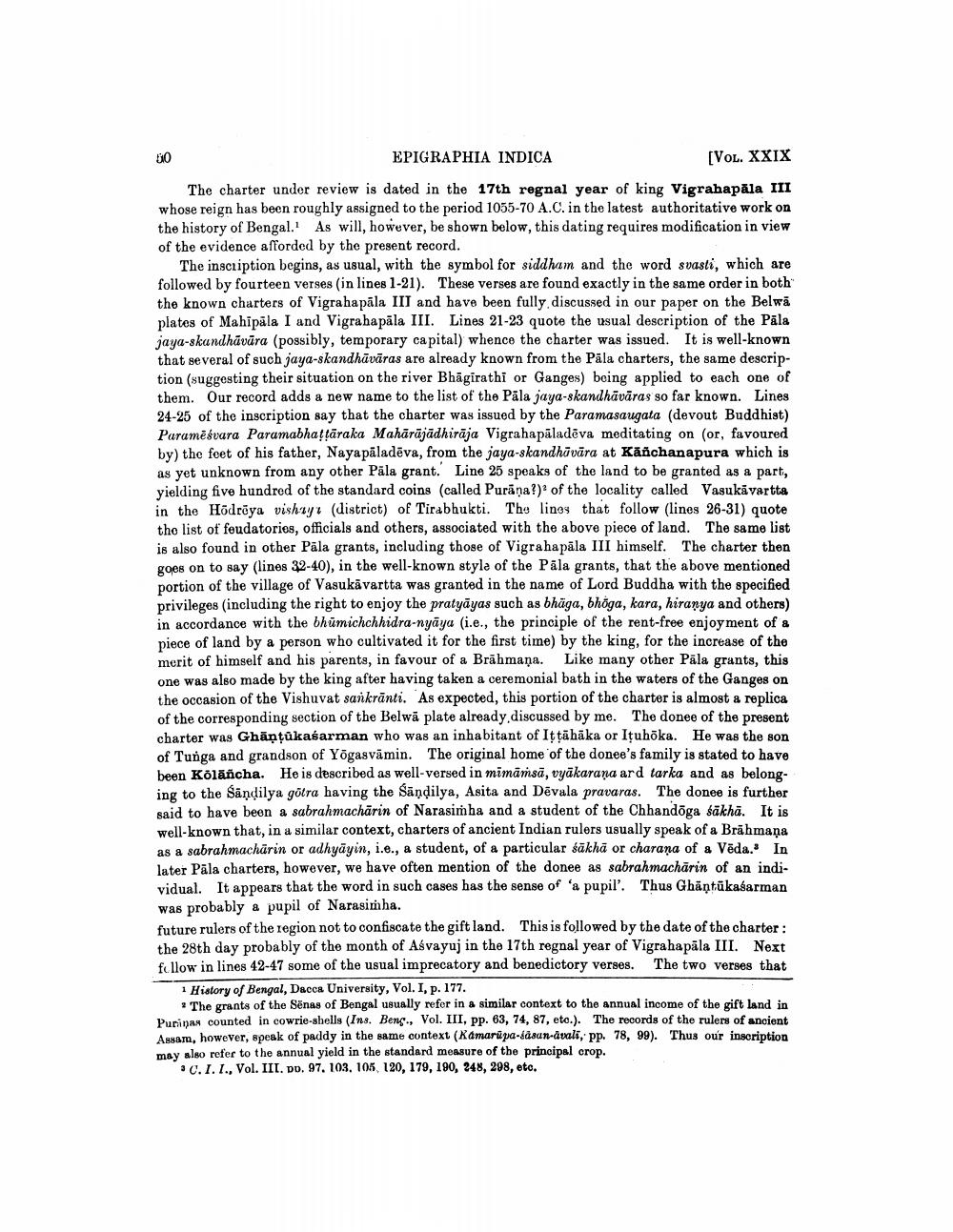________________
50
EPIGRAPHIA INDICA
[VOL. XXIX
The charter under review is dated in the 17th regnal year of king Vigrahapāla III whose reign has been roughly assigned to the period 1055-70 A.C. in the latest authoritative work on the history of Bengal. As will, however, be shown below, this dating requires modification in view of the evidence afforded by the present record.
The inscription begins, as usual, with the symbol for siddham and the word svasti, which are followed by fourteen verses (in lines 1-21). These verses are found exactly in the same order in both the known charters of Vigrahapala III and have been fully discussed in our paper on the Belwa plates of Mahipala I and Vigrahapala III. Lines 21-23 quote the usual description of the Pāla jaya-skandhāvāra (possibly, temporary capital) whence the charter was issued. It is well-known that several of such jaya-skandhāvāras are already known from the Pala charters, the same description (suggesting their situation on the river Bhagirathi or Ganges) being applied to each one of them. Our record adds a new name to the list of the Pāla jaya-skandhāvāras so far known. Lines 24-25 of the inscription say that the charter was issued by the Paramasaugata (devout Buddhist) Paramesvara Paramabhaṭṭāraka Mahārājādhirāja Vigrahapaladēva meditating on (or, favoured by) the feet of his father, Nayapaladeva, from the jaya-skandhāvāra at Kanchanapura which is as yet unknown from any other Pāla grant. Line 25 speaks of the land to be granted as a part, yielding five hundred of the standard coins (called Purana?) of the locality called Vasukavartta in the Hōdroya vishay (district) of Tirabhukti. The lines that follow (lines 26-31) quote the list of feudatories, officials and others, associated with the above piece of land. The same list is also found in other Pala grants, including those of Vigrahapala III himself. The charter then goes on to say (lines 32-40), in the well-known style of the Pala grants, that the above mentioned portion of the village of Vasukavartta was granted in the name of Lord Buddha with the specified privileges (including the right to enjoy the pratyāyas such as bhäga, bhoga, kara, hiranya and others) in accordance with the bhumichchhidra-nyaya (i.e., the principle of the rent-free enjoyment of a piece of land by a person who cultivated it for the first time) by the king, for the increase of the merit of himself and his parents, in favour of a Brahmana. Like many other Pāla grants, this one was also made by the king after having taken a ceremonial bath in the waters of the Ganges on the occasion of the Vishuvat sankranti. As expected, this portion of the charter is almost a replica of the corresponding section of the Belwa plate already discussed by me. The donee of the present charter was Ghaṇṭūkasarman who was an inhabitant of Iṭṭāhāka or Iṭuhōka. He was the son of Tunga and grandson of Yogasvamin. The original home of the donee's family is stated to have been Kōlancha. He is described as well-versed in mimāṁsā, vyākaraṇa ard tarka and as belonging to the Sandilya götra having the Sandilya, Asita and Devala pravaras. The donee is further said to have been a sabrahmacharin of Narasimha and a student of the Chhandōga śākhā. It is well-known that, in a similar context, charters of ancient Indian rulers usually speak of a Brāhmaṇa as a sabrahmacharin or adhyayin, i.e., a student, of a particular sakha or charana of a Věda. In later Pāla charters, however, we have often mention of the donee as sabrahmacharin of an individual. It appears that the word in such cases has the sense of a pupil'. Thus Ghantūkasarman was probably a pupil of Narasimha.
future rulers of the region not to confiscate the gift land. This is followed by the date of the charter: the 28th day probably of the month of Asvayuj in the 17th regnal year of Vigrahapala III. Next follow in lines 42-47 some of the usual imprecatory and benedictory verses. The two verses that
1 History of Bengal, Dacca University, Vol. I, p. 177.
The grants of the Senas of Bengal usually refer in a similar context to the annual income of the gift land in Purinas counted in cowrie-shells (Ins. Beng., Vol. III, pp. 63, 74, 87, etc.). The records of the rulers of ancient Assam, however, speak of paddy in the same context (Kamarupa-tasan-avali, pp. 78, 99). Thus our inscription may also refer to the annual yield in the standard measure of the principal crop.
C. I. I., Vol. III. DD. 97, 103, 105, 120, 179, 190, 248, 298, etc.




